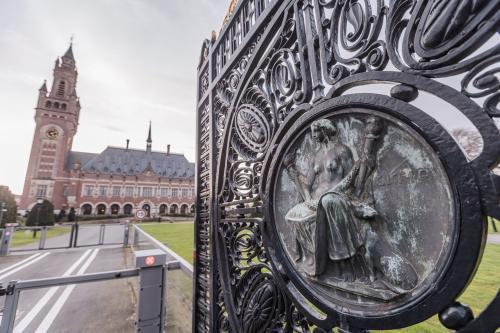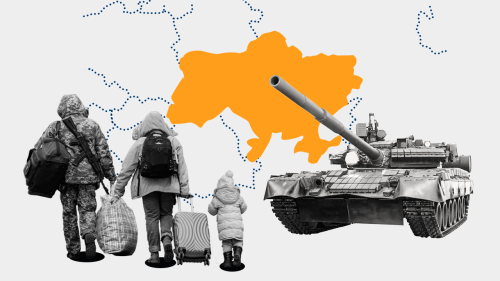On 17 February 2001, the freighter East Sea ran aground on the French Riviera with nine hundred Kurds on board, mainly from Syria, after its crew of smugglers abandoned ship. Three years earlier, France had heavily criticized the Italian government when 825 Kurds aboard the ship Ararat landed in the South of Italy. Now France, like Italy, has been forced to acknowledge that it has become a transit country for asylum seekers and illegal migrants trying to make their way to the United Kingdom or northern Europe. Indeed over a third of the East Sea passengers “disappeared” without claiming asylum in France, where they had little chance of success in any case. Their disappearance prompted the ire of Britain’s home office secretary Jack Straw, who feared that they were on their way to England. Since 1999, a makeshift camp in the small French town of Sangatte, in the Nord-Pas-de-Calais region, has housed thousands of people wishing to cross the Channel to England by jumping on trucks or trains in Calais. Both the Sangatte camp and the East Sea incident have heightened tensions between the French and British governments over immigration policy.
The beaching of the East Sea also created political tensions within France. France’s Socialists, reluctant to appear lenient on migration, called for a firm response to the Kurdish immigrants in order to deter further arrivals. Politicians on the right, by contrast, called for solidarity with a people oppressed by Middle Eastern powers. What France’s political elite did agree on was the need for a European solution to the question of immigration and human smuggling. In fact, since the Treaty of Amsterdam entered into force in May 1999, immigration and asylum policy has become a European Union matter. EU countries (minus the UK, Ireland, and Denmark which have opted out) and associated Schengen countries (Iceland and Norway) can now adopt unified European legislation in this policy area. France, when it held the presidency of the European Union in the fall of 2000, made a series of proposals to harmonize sanctions against carriers and facilitators of illegal migration. These proposals were adopted by the Council of Ministers under the Swedish Presidency in May 2001.
Postwar Immigration Policy
In the immediate postwar period, France was the only country in Europe to encourage permanent immigration. In this respect its policy resembled that of the United States. Yet, as elsewhere in Western Europe, France’s recruitment of new workers halted with the first oil shock in 1973. There were even attempts, under the conservative presidency of Valéry Giscard d’Estaing, to reverse the flow of immigrants by refusing to renew their residency permits. These projects failed, primarily because France’s public administration used procedural means to block them. Since 1973, immigration policy in France has focused primarily on stemming and deterring migration. This contrasts with the United States, which welcomes large numbers of labor and family migrants. And unlike the United States, where organized business and ethnic interests have lobbied for expansive immigration legislation, France has no organized interest groups advocating greater immigration. Moreover, socioeconomic restructuring and economic downturns since the 1970s have meant that French employers have not needed (legal) foreign labor, while high unemployment has fed xenophobic sentiments in public opinion and in populist rhetoric.
France has nonetheless continued to receive legal immigrants, with approximately 100,000 new entries per year. The legal flows have included EU migrants who enjoy free movement rights, family members of legal residents, whose rights are protected by domestic law, and refugees and asylum-seekers admitted on the basis of constitutional and international law. These are mainly unsolicited migrants, those whose rights of entry and stay are guaranteed by constitutional norms and international agreements. France’s Conseil d’Etat, its highest administrative court, has since the late 1970s played a key role in defending these groups. As successive governments have sought to stem migration flows and to issue more expulsion orders, France’s high courts have entered the fray of immigration politics. Legal aid groups such as the “Group to Inform and Support Immigrant Workers” have helped the courts in this effort. Together, the courts and the Conseil d’Etat have greatly limited state discretion in the area of migration control.
The latest French census, published in March 1999, showed that there were 3,263,000 foreigners in France (5.6 percent of the total population). This represented a 9 percent decrease in the foreign population since the 1990 census. Although the percentage of foreigners in the French population remains above the EU average of 4.4 percent, France is the only EU member state, and OECD country, where the number of immigrants has decreased over this period.
Part of the decrease is due to the naturalization of about 60,000 foreigners every year, and part is due to mortality. Yet it should be emphasized that one quarter of the foreigners who have entered France since 1990 have since left the country (220,000 out of 850,000 entries since 1990). This high rate of departure is due in part to the weak economic climate in France during much of this period.
Politics and Immigration
While these numbers do not point to a migration “crisis” in France, the issue has nonetheless been more highly politicized, and for a longer time, than elsewhere in Europe. Features of the French political system help explain this political attention. First, French electoral laws have encouraged a focus on immigration. Unlike the multi-polar party systems in other continental European countries, which encourage complex coalitions across multiple policy areas, France’s winner-take-all electoral system has led the left and right to exaggerate partisan differences. As macroeconomic and industrial policy ceased to be divisive political questions in France—especially with the 1983 policy reversals of François Mitterrand’s Socialist party—the political left and right seized on new societal issues such as immigration. After successive national electoral campaigns (legislative and presidential) in which each new government worked to undo previous legislation, France now holds a record for legislative change in the area of immigration. Major reforms were passed in 1980, 1984, 1987, 1989, 1993, 1997, and most recently in 1998. The political debate expanded over time to include the role of immigration in such issues as national identity, migrant incorporation, security, and terrorism. Mobilization of both pro- and anti-migrant forces has fed the political fire. France is the only country to have witnessed a large-scale migrant social movement in each of the past three decades: the migrant workers? rent strikes in the 1970s, the “second generation” movement in the 1980s, and the sans papiers (those without documents) mobilization in the 1990s. Counter-mobilization by the extreme right has also fed the political debate on immigration. It has pushed leading mainstream politicians on the right to address the immigration issue, in order either to win back voters from the far right, or to cause competing parties to lose votes to the National Front.
By the early 1990s, even though immigration in all categories of legal entries had fallen, Jean-Marie Le Pen’s extreme-right National Front party was attracting a significant portion of the electorate with its demagogic demand to expel Muslim immigrants from France. Politicians across the political spectrum responded by arguing in favor of “immigration zéro,” and the right-wing coalition that came into power in 1993 translated the principle of zero immigration into policy. The “Pasqua law” of 1993, named after French interior minister Charles Pasqua, sought to stem the remaining legal flows in a variety of ways: by prohibiting foreign graduates from accepting job offers by French employers and denying them a stable residence status, by increasing the waiting period for family reunification from one to two years, and by denying residency permits to foreign spouses who had been illegally in the country prior to marrying.
These repressive measures rendered formerly legal migration flows illegal. Thus today, in spite of a partial regularization of undocumented aliens in 1997, there are still many people living in France known as inexpulsables-irrégularisables. This group—including rejected asylum-seekers from countries to which it is not safe to return, and foreign parents of French children—cannot be expelled, yet is not eligible for residency permits. They epitomize the contradictions of liberal democracies in the face of migration pressure, caught between respecting the human rights and norms embedded in domestic and international law, and an electoral logic that leads politicians to adopt a restrictive stance towards immigration.
The 1998 Law on Immigration
When Socialist Prime Minister Lionel Jospin came into office in 1997, he chose the prominent political scientist Patrick Weil to write a report, L’immigration et la nationalité, that laid the groundwork for a new immigration law adopted in 1998. Weil argued that the 1993 Pasqua law deterred foreign students and young professionals from settling in France. It thereby deprived the country of a source of human capital and undermined its national interests in the global competition for the brightest minds. Weil?s policy recommendations were in fact inspired by the American model, in particular the US visa provisions for highly skilled immigrants. The 1998 law on immigration created a special status for scientists and for scholars. Further measures introduced that year aimed at easing the conditions of entry for certain highly skilled professional categories. Computer experts earning more than 180,000 FF per year, and highly qualified temporary workers earning more than 23,000 FF per month, both benefit from a simplified procedure and, if they obtain a one-year permit, can request family reunification. Despite these reforms, France still appears to lag behind the United States, Germany, and the United Kingdom in its quest for highly skilled mobile labor.
Three years after the 1998 law on immigration and residency, France’s political left and right appear to have agreed not to disagree on immigration, at least at the national level. The new consensus still privileges the restrictive function of immigration policy. And the emerging EU regime on immigration and asylum, negotiated by national interior and justice ministry bureaucrats, is also characterized by a general policy of restrictiveness. Yet, as the East Sea episode has shown, policy instruments such as visas and carrier sanctions that seek to prevent “unwanted” migrants from reaching Europe?s border have not stopped their arrival. They have instead criminalized the migration process itself, and raised the demand for smuggling networks and their lucre. France and the European Union today are witnessing the same perverse effects that the US experienced along its Mexican border, where new restrictions in some states only redirected flows to others, and raised the price of illegal passage.
Virginie Guiraudon is a permanent research fellow at the National Center for Scientific Research (CNRS) in France and author of Les politiques d?immigration en Europe. She holds a Ph.D. from Harvard University.



Commentary
Immigration Policy in France
July 1, 2001